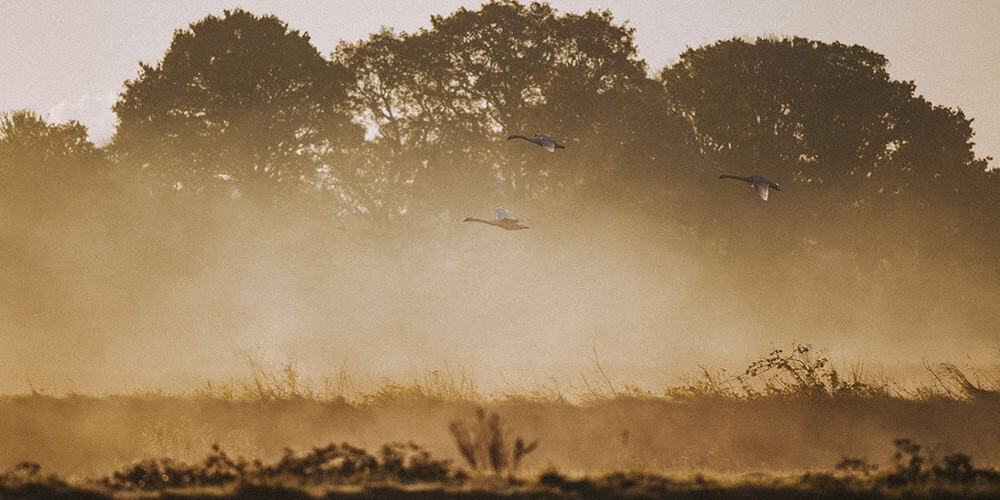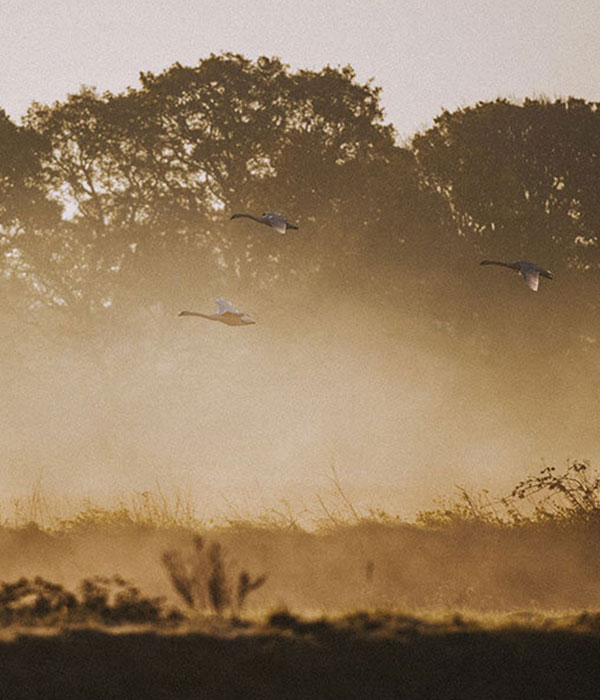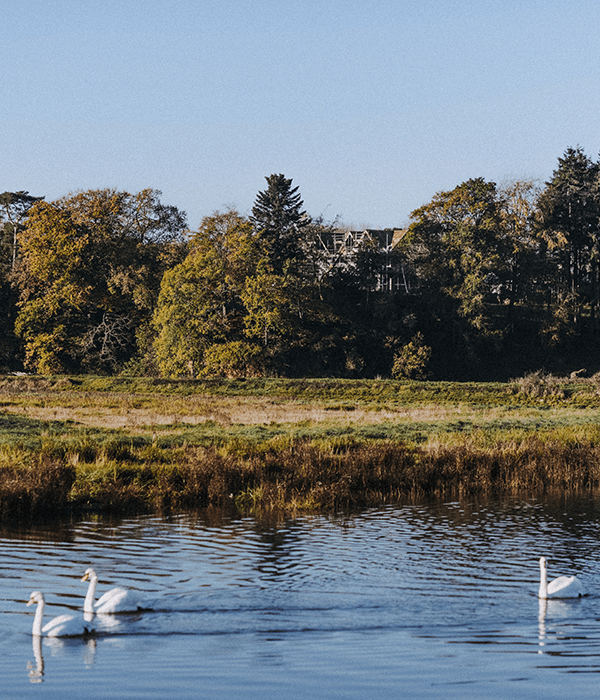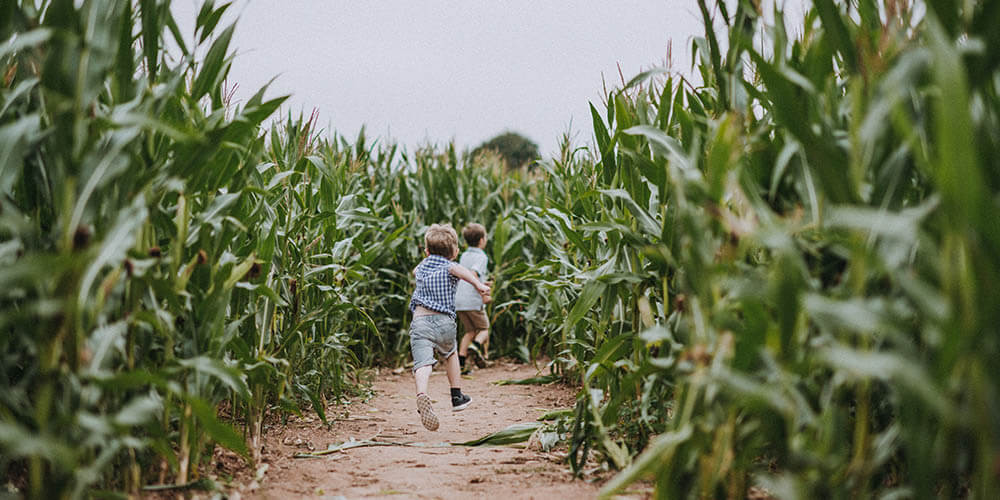Topsham, Devon
EX3 0QH
Tel: 01392 878 200
Email: info@dartsfarm.co.uk
- Gallery
- Love Darts
- Blog & Recipes
- Opening Hours
- Contact Us
- My Account
Darts Farm

The Power of our Wetlands
Posted in The Farm on 02 Feb 2022

The Power of our Wetlands
carbon locking & full of life
Overlooking the Clyst Valley, our farmland is surrounded by unique wetlands, which are perfect for carbon-storing, and create habitats for our local wildlife.
As part of our century old rotational practices, in the summer months, our Ruby Reds keep the soil fertile with their dung and encourage a new growth of grass which helps to lock and reduce carbon.
During the winter months, we raise water levels of the same area that the cattle graze which helps to stimulate bio-diversity and to encourage migratory wildlife to flock and flourish.
 What are wetlands and why are they important?
What are wetlands and why are they important?
Wetlands are distinct ecosystems; areas of ground that are permanently or seasonally flooded and are one of the most effective stores for carbon to be locked away, as well as offering wildlife a thriving habitat too.
Carbon is held within living vegetation, as well as in peats, organic soils, and sediments; and is released when they decompose, but thanks to the wetland’s conditions, these materials are buried in the soils, thus storing the carbon so it cannot be released into the atmosphere.
Wetlands play a huge part in our local ecosystem, with around 40% of species living and breeding in wetlands. For us on the farm, this ranges from chattering warblers, dragonflies and damselflies, to ducks, swans and Brent & Canada geese who migrate to the Exe Estuary over the winter. Over the last 100 years, 90% of wetlands have been lost to development and urbanisation, but thankfully, the country is catching up with what we always knew - realising the importance of wetlands and the part they play in storing carbon - and an effort is being made to restore wetlands across the country.
We take huge pride in our wetlands and value the importance of them in our sustainable farming practices; helping with drainage to encourage good soil health and fertility, feeding nutrients into the ground and to wildlife, and capturing and storing carbon in our local environment.
We are so lucky to have been working with the RSPB here for over 15 years at Darts Farm. The team’s dedication to conservation and sustainability helps our local wildlife, birds and environment to thrive. Through carefully managing their nature reserves to protect endangered species and sharing wildlife-friendly farming techniques, they help us to create a food system that supports a countryside full of birds and other wildlife. Not to mention, they are always on hand to let you know what you can spot whilst walking around the farm and wetlands.
Create your own mini wetland in your garden at home!
With a little effort, you can create a mini-wetland in your own garden. By doing so, you´ll be doing your bit for storing Carbon, as well as helping to provide habitat for a host of creatures; from butterflies and bees to toads, frogs and birds.
Step 1
Find a quiet area in your garden, with some partial shade or shrubbery. If you have an existing pond, the watery surrounding edges will be perfect!
Step 2
Begin by outlining the shape with twine or a garden hose. Scoop off the sod and dig a one-foot-deep hollow. (To accommodate trees and large shrubs on the fringes, dig the holes at least two feet deep.) Line the hollowed area with well-compacted clay. If your site is naturally and constantly moist, it will not require lining with clay except in a small area where you may want to create a tiny pool.
Step 3
Fill the clay-lined hollow with two inches of pebbles, followed by two-inch layers of peat moss, coarse builders´ sand and roughly chopped sod. Top with the removed soil and enrich with composted materials, shredded leaves or more chopped sod.
Step 4
There are several ways to keep your artificial wetland garden moist. It can be fed by a fountain spout connected to a recirculating pump immersed in a small pool, or by a fountain spout attached to a garden hose. Sink the hose one inch or so into the ground to protect it from the lawnmower. Or you can bury a perforated soaker hose two to three inches below the soil level.
Step 5
Some trees and shrubs, such as birch, red-osier dogwood, Alder, Willow and mountain laurel, provide not only food and shelter but add texture and color to the landscape during the bleaker months. Swamp maple, with its red stems and red leaves, adds an ornamental touch in the Autumn in some areas. In southern areas, sweet gum makes a beautiful addition to a wetland. If you live in the north, try tamarack.
Be part of our community
Tags
- Food Hall
- Recipes
- The Farm
- News
- Awards
- Lifestyle
- Fitness & Wellbeing
- Food & Drink
- Seasonality
- Charity
- Supporting Local
- The Fish Shed
- Butchers
- The Flower Shack
- Energy Hair
- Winter Recipe
- Autumn Recipe
- Spring Recipe
- Summer Recipe
- The Farm Table
- July 2017 (1)
- July 2017 (1)
- November 2017 (1)
- December 2017 (1)
- May 2018 (1)
- June 2018 (1)
- July 2018 (1)
- July 2018 (1)
- July 2018 (1)
- August 2018 (1)
- August 2018 (1)
- August 2018 (1)
- August 2018 (1)
- September 2018 (1)
- September 2018 (1)
- September 2018 (1)
- September 2018 (1)
- September 2018 (1)
- October 2018 (1)
- October 2018 (1)
- October 2018 (1)
- November 2018 (1)
- November 2018 (1)
- November 2018 (1)
- December 2018 (1)
- January 2019 (1)
- January 2019 (1)
- February 2019 (1)
- February 2019 (1)
- March 2019 (1)
- March 2019 (1)
- March 2019 (1)
- May 2019 (1)
- May 2019 (1)
- May 2019 (1)
- May 2019 (1)
- May 2019 (1)
- May 2019 (1)
- May 2019 (1)
- May 2019 (1)
- June 2019 (1)
- June 2019 (1)
- June 2019 (1)
- June 2019 (1)
- June 2019 (1)
- June 2019 (1)
- June 2019 (1)
- July 2019 (1)
- July 2019 (1)
- July 2019 (1)
- July 2019 (1)
- July 2019 (1)
- August 2019 (1)
- September 2019 (1)
- September 2019 (1)
- October 2019 (1)
- November 2019 (1)
- November 2019 (1)
- November 2019 (1)
- December 2019 (1)
- December 2019 (1)
- December 2019 (1)
- December 2019 (1)
- December 2019 (1)
- December 2019 (1)
- December 2019 (1)
- December 2019 (1)
- December 2019 (1)
- December 2019 (1)
- December 2019 (1)
- January 2020 (1)
- January 2020 (1)
- January 2020 (1)
- January 2020 (1)
- January 2020 (1)
- January 2020 (1)
- January 2020 (1)
- January 2020 (1)
- January 2020 (1)
- January 2020 (1)
- January 2020 (1)
- January 2020 (1)
- January 2020 (1)
- January 2020 (1)
- January 2020 (1)
- January 2020 (1)
- January 2020 (1)
- January 2020 (1)
- January 2020 (1)
- January 2020 (1)
- January 2020 (1)
- January 2020 (1)
- January 2020 (1)
- February 2020 (1)
- February 2020 (1)
- February 2020 (1)
- February 2020 (1)
- February 2020 (1)
- February 2020 (1)
- February 2020 (1)
- February 2020 (1)
- February 2020 (1)
- February 2020 (1)
- February 2020 (1)
- March 2020 (1)
- March 2020 (1)
- March 2020 (1)
- March 2020 (1)
- March 2020 (1)
- March 2020 (1)
- April 2020 (1)
- April 2020 (1)
- April 2020 (1)
- April 2020 (1)
- April 2020 (1)
- April 2020 (1)
- April 2020 (1)
- April 2020 (1)
- April 2020 (1)
- April 2020 (1)
- April 2020 (1)
- April 2020 (1)
- May 2020 (1)
- May 2020 (1)
- May 2020 (1)
- May 2020 (1)
- May 2020 (1)
- May 2020 (1)
- May 2020 (1)
- June 2020 (1)
- June 2020 (1)
- June 2020 (1)
- June 2020 (1)
- June 2020 (1)
- June 2020 (1)
- June 2020 (1)
- June 2020 (1)
- July 2020 (1)
- July 2020 (1)
- July 2020 (1)
- July 2020 (1)
- July 2020 (1)
- July 2020 (1)
- August 2020 (1)
- August 2020 (1)
- August 2020 (1)
- August 2020 (1)
- August 2020 (1)
- August 2020 (1)
- August 2020 (1)
- September 2020 (1)
- September 2020 (1)
- September 2020 (1)
- September 2020 (1)
- September 2020 (1)
- September 2020 (1)
- September 2020 (1)
- October 2020 (1)
- October 2020 (1)
- October 2020 (1)
- October 2020 (1)
- October 2020 (1)
- November 2020 (1)
- November 2020 (1)
- December 2020 (1)
- December 2020 (1)
- December 2020 (1)
- January 2021 (1)
- January 2021 (1)
- January 2021 (1)
- January 2021 (1)
- February 2021 (1)
- February 2021 (1)
- March 2021 (1)
- April 2021 (1)
- April 2021 (1)
- May 2021 (1)
- May 2021 (1)
- May 2021 (1)
- May 2021 (1)
- May 2021 (1)
- June 2021 (1)
- June 2021 (1)
- June 2021 (1)
- June 2021 (1)
- July 2021 (1)
- July 2021 (1)
- July 2021 (1)
- July 2021 (1)
- July 2021 (1)
- August 2021 (1)
- August 2021 (1)
- August 2021 (1)
- August 2021 (1)
- August 2021 (1)
- September 2021 (1)
- September 2021 (1)
- September 2021 (1)
- September 2021 (1)
- October 2021 (1)
- October 2021 (1)
- December 2021 (1)
- December 2021 (1)
- December 2021 (1)
- January 2022 (1)
- January 2022 (1)
- January 2022 (1)
- January 2022 (1)
- February 2022 (1)
- February 2022 (1)
- February 2022 (1)
- February 2022 (1)
- February 2022 (1)
- February 2022 (1)
- February 2022 (1)
- February 2022 (1)
- February 2022 (1)
- February 2022 (1)
- March 2022 (1)
- March 2022 (1)
- March 2022 (1)
- April 2022 (1)
- April 2022 (1)
- May 2022 (1)
- May 2022 (3)
- May 2022 (1)
- May 2022 (1)
- May 2022 (1)
- May 2022 (1)
- May 2022 (1)
- June 2022 (1)
- July 2022 (1)
- July 2022 (1)
- August 2022 (1)
- August 2022 (1)
- September 2022 (1)
- September 2022 (1)
- September 2022 (1)
- September 2022 (1)
- September 2022 (1)
- September 2022 (1)
- October 2022 (1)
- October 2022 (1)
- October 2022 (1)
- October 2022 (1)
- October 2022 (1)
- October 2022 (1)
- October 2022 (1)
- November 2022 (1)
- November 2022 (1)
- November 2022 (1)
- November 2022 (1)
- December 2022 (1)
- December 2022 (1)
- December 2022 (1)
- December 2022 (1)
- December 2022 (1)
- December 2022 (1)
- January 2023 (1)
- January 2023 (1)
- January 2023 (1)
- February 2023 (1)
- February 2023 (1)
- March 2023 (1)
- April 2023 (1)
- April 2023 (1)
- April 2023 (1)
- April 2023 (1)
- April 2023 (1)
- April 2023 (1)
- April 2023 (1)
- April 2023 (1)
- May 2023 (1)
- May 2023 (1)
- May 2023 (1)
- May 2023 (1)
- June 2023 (1)
- June 2023 (1)
- June 2023 (1)
- June 2023 (1)
- June 2023 (1)
- July 2023 (1)
- July 2023 (1)
- July 2023 (1)
- August 2023 (1)
- August 2023 (1)
- August 2023 (1)
- August 2023 (1)
- August 2023 (1)
- September 2023 (1)
- September 2023 (1)
- October 2023 (1)
- October 2023 (1)
- October 2023 (1)
- November 2023 (1)
- November 2023 (1)
- November 2023 (1)
- November 2023 (1)
- November 2023 (1)
- December 2023 (1)
- December 2023 (1)
- December 2023 (1)
- December 2023 (1)
- January 2024 (1)
- January 2024 (1)
- January 2024 (1)
- January 2024 (1)
- January 2024 (1)
- January 2024 (1)
- January 2024 (1)
- February 2024 (1)
- February 2024 (1)
- February 2024 (1)
- February 2024 (1)
- February 2024 (1)
- February 2024 (1)
- March 2024 (1)
- March 2024 (1)
- March 2024 (1)
- March 2024 (1)
- March 2024 (1)
- March 2024 (1)
- April 2024 (1)
- April 2024 (1)
- April 2024 (1)
- April 2024 (1)
- April 2024 (1)
- May 2024 (1)
- May 2024 (1)
- June 2024 (1)
- July 2024 (1)
- July 2024 (1)
- July 2024 (1)
- July 2024 (1)
- July 2024 (1)
- August 2024 (1)
- August 2024 (1)
- September 2024 (1)
- October 2024 (1)
- December 2024 (1)
- December 2024 (1)
- December 2024 (1)
- December 2024 (1)
- December 2024 (1)
- December 2024 (1)
- December 2024 (1)
- January 2025 (1)
- January 2025 (1)
- January 2025 (1)
- February 2025 (1)
- February 2025 (1)
- February 2025 (1)
- February 2025 (1)
- March 2025 (1)
- March 2025 (1)
- March 2025 (1)
- March 2025 (1)
- March 2025 (1)
- March 2025 (1)
Related blog posts
.jpg)
Our Pick Your Own Sunflowers are ready
Come and join us and pick our Sunflowers for Charity!

Our Amazing Maize Maze is now open
Have a day of farm fun with our Maize Maze!
